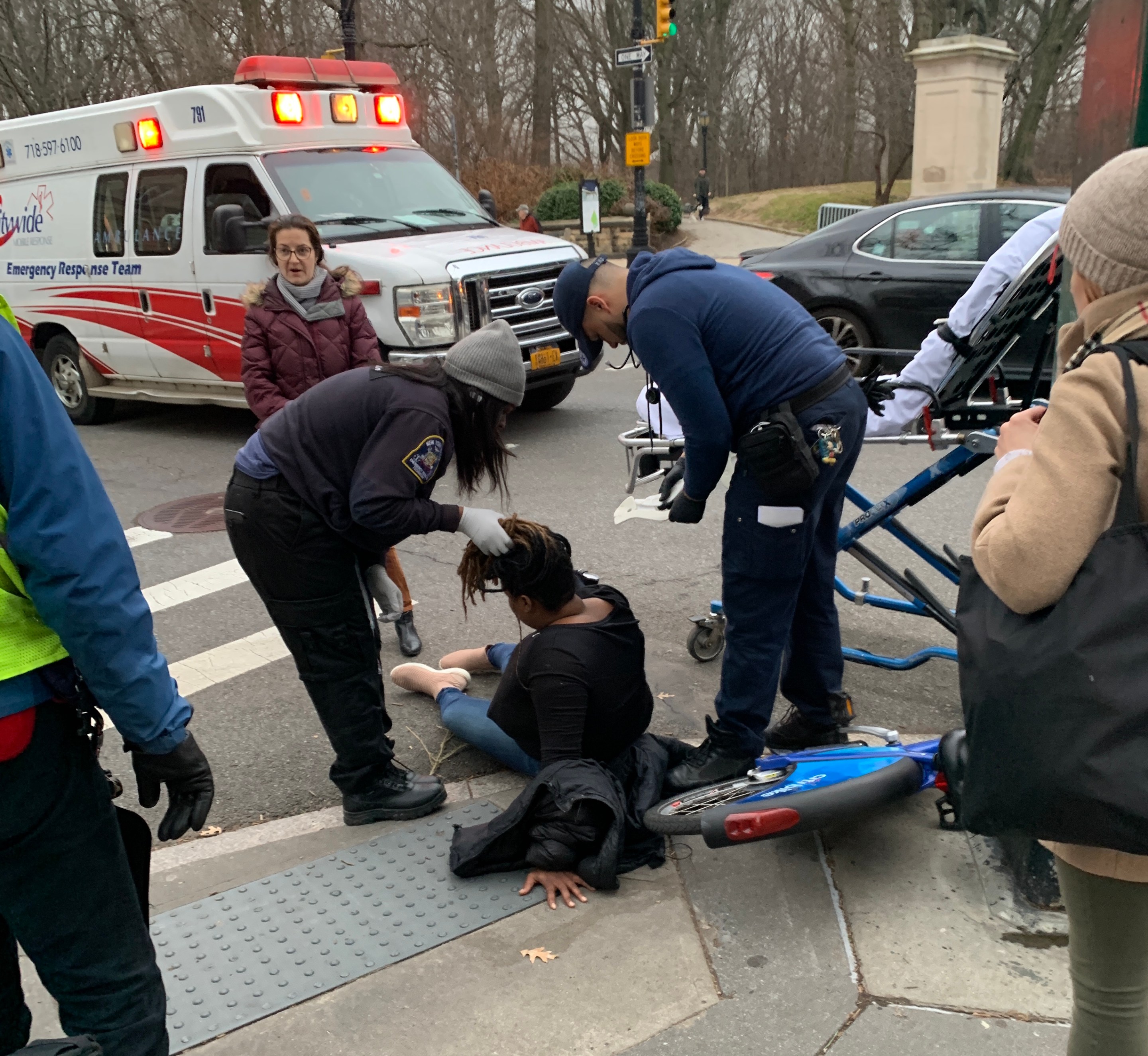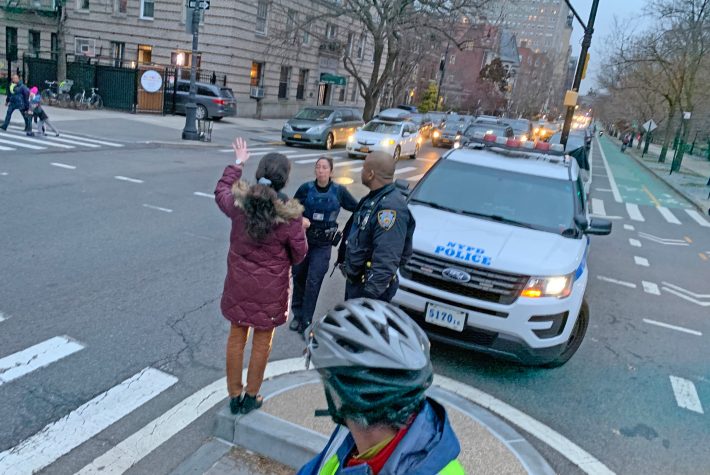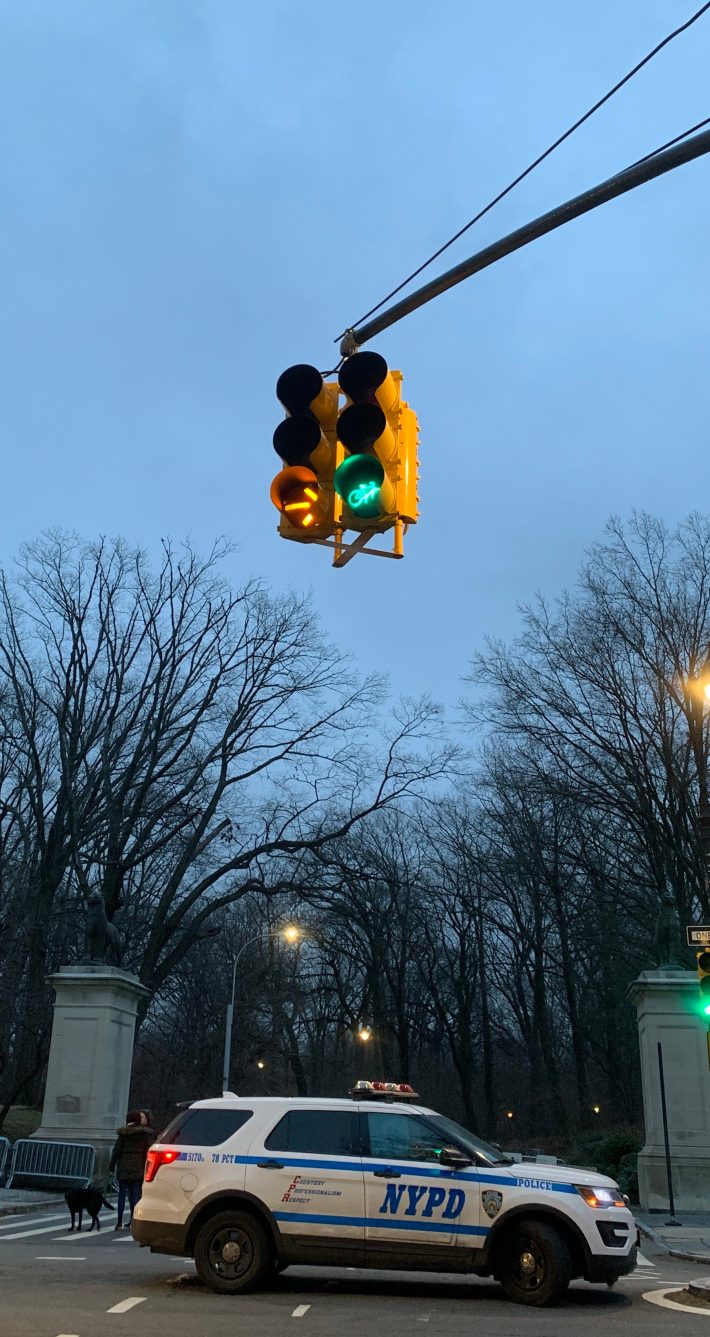CYCLE OF RAGE: Crash Response Reveals that Cops Are Just So Badly Trained
12:01 AM EST on January 15, 2020

This was the scene on Third Street at Prospect Park West at around 4:15 p.m. on Monday — an injured cyclist who is long gone by the time cops show up. Photo: Gersh Kuntzman
City & State NY is hosting a full day New York in Transit summit on Jan. 30 at the Museum of Jewish Heritage. This summit will bring together experts to assess the current state of New York’s transportation systems, break down recent legislative actions, and look towards the future of all things coming and going in New York. Join Keynote Speaker Polly Trottenberg, commissioner of the NYC Department of Transportation, along with agency leaders, elected officials, and advocates. Use the code STREETSBLOG for a 25-percent discount when you RSVP here!
People often ask why so few car drivers are punished for injuring or killing pedestrians and cyclists.
There are many reasons — a legal system that treats crashes as unavoidable "accidents," but the central one is simple: police officers are poorly trained and disinclined to see drivers as a culprit in the criminal or civil offense that is injuring or killing someone with a motor vehicle.
I have heard this complaint from victims numerous times, but saw it for myself on Monday night in Park Slope. Here's what happened:
I was biking home on my normal route at around 4:15 p.m when I witnessed the aftermath of a crash between a car driver and a cyclist on Prospect Park West and Third Street. The details of this story hinge on the intersection itself, which I know intimately because I bike past it twice a day, so let's start there:
Third Street is a one-way eastbound street with a painted bike lane on the south side of the roadway. The street runs up the slope that gives the tony Brooklyn neighborhood its name and terminates at Prospect Park West, a two-lane roadway with a two-way protected bike lane on the far side of the intersection.
At the intersection, cyclists get a green light before drivers. Cyclists must bike straight, either into Prospect Park or to the protected bike lane. Drivers must turn right onto Prospect Park West, but can only do so when their light changes from red to a yellow caution arrow. Drivers never have the right of way at that intersection, and can only make their turn if there is not a cyclist (or, of course, a pedestrian) crossing Prospect Park West.
All of this information, while minute, is crucial because it provides a basic overview that must be understood before anyone can determine the range of possibilities that led to a crash.

So when I arrived on the scene, I found a woman writhing in pain on the southwest corner of Third Street and Prospect Park West. Her Citi Bike was on the pavement near her. The driver of a red Toyota was standing a short distance away, her car on Prospect Park West (she had turned right from Third Street onto PPW). EMTs were treating the woman for injuries she apparently sustained in the crash.
The woman was soon loaded into an ambulance and removed to Methodist Hospital, a few blocks away.
Two officers from the 78th Precinct showed up about 10 minutes later — roughly 30 minutes after the crash. That is not a criticism, but this is: Their investigation into the crash was a complete sham.
To be clear, I did not see the crash, but only the aftermath — but that only makes me more infuriated by what I saw from New York's Finest. The officers made no effort to actually determine what happened, first asking the driver perfunctory questions such as the location of her car and what she saw before the crash (I overheard her say to one officer that she is a "safe driver" and that the cyclist "was in my blind spot." Let's hold onto that for a second.)
The officers were sympathetic to the driver, who did indeed appear to be shocked by the crash. The officers did not ask follow up with the driver on her possible culpability, including additional questions about that alleged "blind spot." (Reminder: cars do not have blind spots; drivers have inattentiveness and haste.)

At no time did one of the officers walk over to the actual crash site and examine the street's unique design and circumstances. No one considered the spot where the car and bicycle collided. No measurements or even approximations were taken. Nor did anyone watch the traffic signal go through its cycle — a) red for all vehicles, b) green for cyclists and red for drivers, c) green for cyclists, yellow yield arrow for drivers — to see that drivers never have the right of way through that intersection.
And worse, no one checked the woman's driving record or the record of the car, which, it turns out, has been slapped six times for camera-issued speeding tickets, according to city data. That certainly does not mean the woman was driving poorly before the Monday crash, but you would think that anyone investigating a crash would want to know the driving record of the central witness — one who can easily exonerate herself in the absence of the victim removed to a hospital.
Then a witness emerged — a man who claimed he had seen "the whole thing." Cops asked him for details of what he saw, and he spun a tale — possibly true, possibly false, but certainly subject to skepticism, given how studies have repeatedly shown how unreliable crash witnesses are — that painted the Citi Bike rider as a "professional victim" (his words). He claimed that he had watched her waiting at the light until the woman in the red Toyota prepared to make her turn, then "speed up" so that she — the cyclist — crashed into the Toyota, and not the other way around. Given the rising slope of Third Street, the sluggishness of Citi Bikes, and the rider's girth, the witness's description of the moments before the crash are certainly suspect.
He also claimed that the driver had the right of way, which is not true under any circumstances at that intersection.
There was also a racial dynamic at play here: The victim being painted as an insurance fraudster was black. The witness was white. The cops did indeed ask what the race of the victim was — though it is unclear why that was relevant. Frankly, it is not. (The cops did not ask any follow-ups, such as hair color, hair style, clothing, etc, which could suggest that they were trying to match this alleged perp with some other fraud suspect. And New York State MV-104 crash reports do not include the race of people involved in collisions. No, this appeared to simply be a racial question of zero value, perhaps designed to confirm the officers' implicit bias that the white driver and witness were honest and the black victim was a liar.)
Of course, remember, I hadn't seen the crash, so I found the witness's testimony fascinating and asked him about it. He claimed his wife had seen the same woman attempt the same fraud an hour earlier — bicycling into the path of a car — but her earlier attempt did not lead to a substantial enough injury, so she tried again.
I was skeptical. Cops bought it.
"It's terrible that someone would do that," one officer said. She and her partner consoled the driver, who was then allowed to leave without receiving any ticket for her role in the crash.
#NY_FXN8167 has been queried 1 time.
— How's My Driving NY (@HowsMyDrivingNY) January 14, 2020
Total parking and camera violation tickets: 16
6 | School Zone Speed Camera Violation
2 | No Parking - Street Cleaning
1 | Blocking Crosswalk
1 | Inspection Sticker Expired Or Missing
1 | Non-Compliance With Posted Sign
It is unclear if the officers went to nearby Methodist Hospital to interview the victim, who was long gone by the time cops showed up and therefore could not offer her testimony or rebut the witness. (I've reached out to the NYPD for more information, but haven't heard back.) If, indeed, cops believe that the woman is a fraudster who crashes bikes into cars for insurance money, they should pursue that case, but it does not appear that they are — more investigative laziness, perhaps.
Of course, what I witnessed only confirmed what I have heard many, many, many, many, many times recently from crash victims — descriptions of encounters with police that suggest that cops do not understand basic road rules, are inclined to take the driver's side whenever there is doubt and don't do a thorough job trying to figure out tricky details of crashes.
In the past, I've asked Mayor de Blasio about this, but he has angrily responded that my questions about police training come from my anti-car "worldview" (as opposed to his worldview that the NYPD is the best trained police force in the country).
Sorry, Mr. Mayor, but I only report what I see.
Streetsblog Editor Gersh Kuntzman writes the Cycle of Rage column, which are archived here.
Gersh Kuntzman is editor in chief of Streetsblog NYC and Streetsblog USA. He also writes the Cycle of Rage column, which is archived here.
Stay in touch
Sign up for our free newsletter
More from Streetsblog New York City
New York City to Install 500 Secure Bike Parking Hubs In The Next Five Years: Sources
Your bike may finally get a roof over its head.
Adams Backs Lower Speed Limits, Calls Crashes ‘Accidents’
The mayor wants New York City drivers to "slow down," but it's not clear yet how many streets will get lower speed limits.
Wednesday’s Headlines: Trump Posts About Congestion Pricing Edition
Donald Trump comments on congestion pricing — no surprise, he's against it. Plus more news.
DOT Aims to Build First Ave. Tunnel Bike Lane Before September’s UN General Assembly
DOT hopes to have the concrete-protect tunnel bike lane installed this summer, but its exact plans are still in development.
Waste Reforms Could Require Data on Crashes, Dangerous Driving
The proposal affects at least one trucking company with a deadly driving record.




